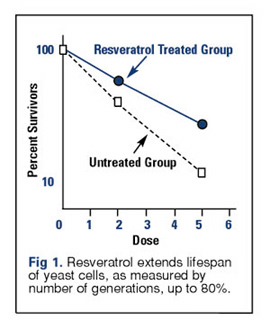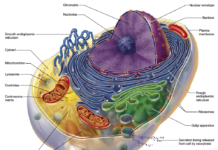By Jim English
Caloric restriction has been shown to be one of the most effective means of slowing the pace of aging and extending lifespan. Studies show that severely reducing the food intake of laboratory mice can increase their lifespan to the human equivalent of 162 years. Other experiments demonstrate similar gains in maximum lifespan with fruit flies and worms. Yet despite the potential increase in lifespan observed with caloric restriction, few humans would willingly choose to live in a constant state of semi-starvation for even a few days, let alone 162 years.
Researchers from Harvard Medical School just announced that resveratrol, a polyphenolic compound found in red wine, duplicates the life-extending benefits of caloric restriction in a yeast model. In a paper published in the August 24 online edition of the journal, Nature, they report that resveratrol was shown to extend the lifespan of yeast by up to 80 percent.
SIR-2 – The Longevity Enzyme
Researchers have known for decades that reducing daily intake of calories by up to 40 percent dramatically slows down the aging process and extends lifespan of lab animals. Caloric restriction also has been shown to protect mammals from cancer and other age-related diseases. Recently scientists identified a class of regulatory “longevity genes” that are shared by almost all living organisms. These genes function as a feedback system to enhance survival during times of stress, such as during drought or famine. The process begins when external signals indicate a deterioration of environmental conditions. Once triggered by environmental cues, the longevity genes “switch on” and induce defensive changes at the cellular level, such as slowing metabolism and enhancing cellular respiration to help the body adapt to a more beneficial survival program.
In their study, the Harvard researchers focused on a family of enzymes, called sirtuins, produced by almost all life forms – from single celled organisms, to plants and mammals – during times of stress, such as famine (or caloric restriction). Sirtuins (silent information regulator proteins) are known to act as guardian enzymes that protect cells and enhance cellular survival. The human sirtuin, SIRT-1, for example, has been shown to suppress the p53 enzyme system normally involved in suppressing tumor growth and instigating cell death (apoptosis). By suppressing p53 activity SIRT-1 prevents the cycle of premature aging and apoptosis normally induced when cellular DNA is damaged or stressed, thus giving cells enough time to repair any damage and prevent unnecessary cell death. A second sirtuin found in yeast, SIR2, has also been shown to become activated when placed under stress. SIR2 has been shown to increase DNA stability and speed cellular repairs, while increasing total cell lifespan.
“We think sirtuins buy cells time to repair damage,” said molecular biologist David Sinclair, assistant professor of pathology at Harvard Medical School and co-author of the new study. “There is a growing realization from the aging field that blocking cell death – as long as it doesn’t lead to cancer – extends lifespan.”
An Alternative to Caloric Restriction
Intrigued by the positive health benefits of caloric restriction, the Harvard research team began to search for other methods of modulating sirtuin activity without resorting to starvation. After an initial screening process, the researchers discovered that several plant metabolites acted as sirtuin-activating compounds (STACs). Plants produce a variety of polyphenols, such as resveratrol, flavones, stilbenes, isoflavones, catechins and tannins in response to environmental stresses, such as drought, nutrient depleted soils, ultraviolet radiation and pathogens. As they refined their screening process the researchers discovered that the most potent activator of sirtuins was resveratrol.
To test the ability of resveratrol to activate sirtuins in living creatures the Harvard researchers selected yeast, a single-celled organism that is closely related to animals, including humans. The research team hypothesized that if resveratrol was effective in modifying the newly identified target genes to trigger sirtuin production it would closely reflect the protein’s role in animals to formally link the protein to lifespan extension, at least for yeast. Their study found that even small doses of resveratrol helped yeast cells live as much as 60 to 80 percent longer, as measured by the number of generations (Fig. 1). Yeast treated with resveratrol lived for an average of 38 generations, as compared to only 19 generations for untreated yeast.

Additional experiments with human cells found that resveratrol activated a similar pathway requiring SIRT1 that enabled 30 percent of the treated human cells to survive gamma radiation compared to 10 percent of untreated cells. In the paper, the researchers also report that preliminary experiments with flies and worms are encouraging, and mouse studies are in the works.
Resveratrol
The fact that human sirtuin SIRT1 turns off the tumor suppressor gene p53 has raised some concern that activating the sirtuin pathway to switch on the cellular longevity program might actually promote cancer. In addressing this issue, Sinclair noted that calorie-restricted animals in experiments by others have lower, not higher rates of cancer. Additional studies also found that resveratrol is able to block all three mechanisms of cancer formation by helping the body inhibit tumor initiation, promotion and progression. Resveratrol has also been shown in numerous clinical trials to benefit heart disease by reducing platelet aggregation and increasing HDL-cholesterol. Resveratrol, in combination with other bioflavonoids and vitamins C and E, may have a synergistic effect by reducing pathological platelet aggregation, stimulating healthy blood flow via the dilation of arteries, and minimizing free radical damage to blood vessel linings.
Conclusion
Research indicates that plant polyphenols, which increase in plants in response to stressful conditions, (similar to conditions found in humans while dieting), help to cue organisms to prepare for impending harsh conditions by switching to a more beneficial survival program. The plant polyphenol, resveratrol, has been shown to act in just such a manner to activate sirtuins to mimic the benefits of caloric restriction to slow aging and extend lifespan – in the case of yeast, up to 80 percent beyond untreated samples. Furthermore, resveratrol has been shown to activate sirtuins, which are also active in human cells, suggesting a potential for lengthening life and preventing or treating aging-related diseases in humans.
Trans- and Cis-Resveratrol
Resveratrol, found in the skins of young unripe red grapes, occurs naturally in two related forms, or isomers, referred to as trans-resveratrol and cis-transrevatrol. Of the two, the trans form (3,5,4′-trihydroxy-trans-stilbene), is the one that has been shown in numerous studies to be the most bioactive and clinically beneficial form of resveratrol. Recommend doses range from 5 mg of trans-resveratrol daily for preventive purposes up to 20 mg, twice daily, for therapeutic purposes.
References
1. Howitz KT, Bitterman KJ, Cohen HY, Lamming DW, Lavu S, Wood JG, Zipkin RE, Chung P, Kisielewski A, Zhang LL, Scherer B, Sinclair DA. Small molecule activators of sirtuins extend Saccharomyces cerevisiae lifespan. Nature. 2003 Sep 11;425(6954):191-6. Epub 2003 Aug 24.
2. Ferguson, L. R. Role of plant polyphenols in genomic stability. Mutat. Res. 475, 89-111, 2001
3. Middleton, E. Jr. Kandaswami, C. Theoharide, T. C. The effects of plant flavonoids on mammalian cells: implications for inflammation, heart disease, and cancer. Pharmacol. Rev. 52, 673-751. 2000.
4. Jang, M. et al. Cancer chemopreventive activity of resveratrol, a natural product derived from grapes. Science 275, 2118-220, 1997.
5. Landryh, J. et al. The silencing protein SIR2 and its homologs are NAD-dependent protein deacetylases. Proc. Natl Acad. Sci. USA 97, 5807-5811. 2000.
6. 2. S. Renaud, M. de Lorgeril (1992) ‘Wine, alcohol, platelets, and the French paradox for coronary heart disease’ Lancet 339, 1523-26.
7. J. South (1997) ‘Acetaldehyde: A common and potent neurotoxin’ VRP Nutr News 11, 1-2, 9-11.
8. M.G. Hertog et al (1993) ‘Dietary antioxidant flavonoids and risk of coronary heart disease: the Zutphen Elderly study’ Lancet 342, 1007-11.
9. H. Arichi et al (1982) ‘Effects of stilbene components of the roots of Polygonum cuspidatum…on lipid metabolism’ Chem Pharm Bull 30, 1766-70.














[…] Resveratrol Mimics Caloric Restriction to Turn on “Longevity Genes” Totul despre polifenoli: definitie, tipuri, beneficii, 10 tipuri de alimente care le contin (infografic) […]